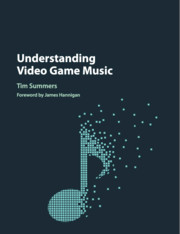Book contents
- Frontmatter
- Dedication
- Contents
- List of Figures, Musical Examples and Tables
- Foreword
- Acknowledgements
- Introduction: Beyond the Candelabrum
- PART I ANALYSING VIDEO GAME MUSIC
- 1 The Video Game as a Source
- 2 Methods of Analysis
- PART II CRITICAL PERSPECTIVES
- Epilogue: Fun, Play and Music
- Appendix: How to Hear a Video Game: An Outline
- Bibliography
- Ludography
- Index of Games
- General Index
1 - The Video Game as a Source
from PART I - ANALYSING VIDEO GAME MUSIC
Published online by Cambridge University Press: 05 September 2016
- Frontmatter
- Dedication
- Contents
- List of Figures, Musical Examples and Tables
- Foreword
- Acknowledgements
- Introduction: Beyond the Candelabrum
- PART I ANALYSING VIDEO GAME MUSIC
- 1 The Video Game as a Source
- 2 Methods of Analysis
- PART II CRITICAL PERSPECTIVES
- Epilogue: Fun, Play and Music
- Appendix: How to Hear a Video Game: An Outline
- Bibliography
- Ludography
- Index of Games
- General Index
Summary
As soon as we begin to engage with the task of learning more about video game music, it becomes apparent that this medium brings with it a certain set of challenges. Some of the issues are methodological, such as the analytical approaches we use to investigate the musical substance of the game, while others speak to more fundamental questions – for example, how do we use the video game as a musical source? The first part of this book is dedicated to dealing with some of the most significant practical concerns about studying game music, while the second part focuses on critical ideas and perspectives that are useful for (and have arisen from) such investigations. Chapter 2 will consider the methods of analysis, but before we can begin to decide how we are going to interrogate the sources, we must first establish the nature of the materials under discussion. To begin we must start with a very basic question – ‘What music is in a video game?’, or, more particularly, ‘What music can we examine when we discuss music in a video game?’
Music in Games
Perhaps the most straightforward way to outline the kinds of musical cue typically found in games is by considering the expected musical content of a game. Figure 1.1 is a generalized model of a mass audience PC/console video game. This figure of the musical architecture of a level-based video game has been informed both by my own experience as a gamer and by instructional texts that have been written for aspiring game composers by industry professionals. Not every type of musical cue identified in the diagram will be evident in every game and this figure does not showcase more unusual musical programming or game structures. Nevertheless, this abstracted model represents a standardized practice and it is useful for identifying the most common musical elements of games, since it shows the types of cue normally included in games. Even if the figure does not accurately match all games (casual handheld games are particularly likely to depart from this model), it distils the archetypal grammar of the mainstream video game.
- Type
- Chapter
- Information
- Understanding Video Game Music , pp. 13 - 32Publisher: Cambridge University PressPrint publication year: 2016

